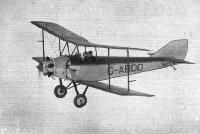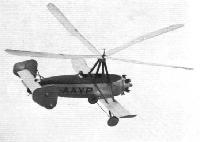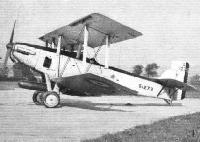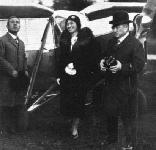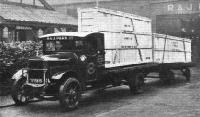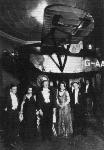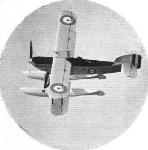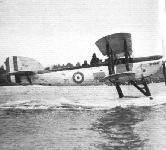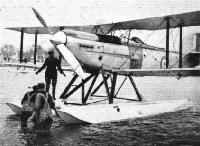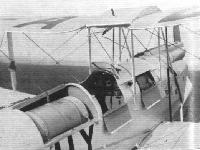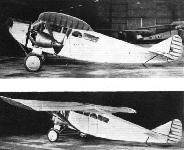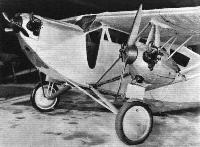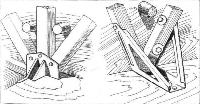Фотографии
-
Регистрационный номер: G-ABDO [2] A WINTER CRUISER: The Robinson "Redwing II," which is fitted with Armstrong Siddeley "Genet" engine, recently made a tour of about 1,000 miles to various towns in England. The machine is here seen at an altitude of 5,000 ft. above the clouds.
G-ABDO was the prototype of this mark of this side-by-side two-seat biplane, designed by John Kenworthy and built by the Robinson Aircraft Co Ltd, founded at Croydon, surrey, by Capt P.G. Robinson. First flown in October 1930, ’BDO was powered by an 80 h.p. Armstrong siddeley Genet IIA air-cooled radial engine. It was used by the newly formed London General Omnibus Company Flying Club, based at Broxbourne, hertfordshire, and the manufacturer’s test pilot, Flt Lt N.M.s. Russell, became the club’s first instructor. Granted its C of A on December 6, 1930, it passed to Miss E.R. Gerrans at Maylands, Romford, essex, in August 1934, but in July 1937 was damaged in a hangar fire at Gravesend in Kent.Самолёты на фотографии: Robinson Redwing - США - 1930
-
Регистрационный номер: G-ABDO [2] The Redwing being flown by Flight-Lieut. Russell, who is the Robinson Aircraft Co.'s chief pilot. The clean lines of the fuselage should be noted.
Самолёты на фотографии: Robinson Redwing - США - 1930
-
Регистрационный номер: G-AAYP [2] The Autogiro C. 19. Mk. III (Genet Major) flown by Mr. Brie at Heston.
Самолёты на фотографии: Cierva/Avro C.19 - Великобритания - 1929
-
Регистрационный номер: G-AAYP [2] THE AUTOGIRO AT HANWORTH: Col. Sempill explains the "old Dutch scenery" to Princess Takamatsu.
Самолёты на фотографии: Cierva/Avro C.19 - Великобритания - 1929
-
Регистрационный номер: S1272 AIRCRAFT TYPES TO BE SEEN IN THE "EAGLE": 1, The Blackburn "Ripon" with Napier "Lion" engine.
Самолёты на фотографии: Blackburn Ripon / T.5 - Великобритания - 1926
-
Регистрационный номер: G-ABGH, K2893 ON TEST AT FELIXSTOWE: The Avro Trainer, type 621 S, has now been fitted with floats, and has just passed very successfully its preliminary tests at Hamble. The machine has now gone to Felixstowe for official tests. The engine is an Armstrong Siddeley "Lynx IV C."
Самолёты на фотографии: Avro Tutor/Sea Tutor/Prefect / Type 621/646/626 - Великобритания - 1929
-
BRITISH AIRCRAFT TYPES WHICH ARE BEING FLOWN AT EL PALOMAR: 3, Avro Advanced Trainer, type 626, Armstrong-Siddeley "Lynx" engine.
Самолёты на фотографии: Avro Tutor/Sea Tutor/Prefect / Type 621/646/626 - Великобритания - 1929
-
JAPANESE INTEREST IN AVIATION: (From right to left), Prince Takamatsu, Princess Takamatsu and Lt.-Comm. Mizuno just after examining a Puss Moth.
Самолёты на фотографии: De Havilland Puss Moth / D.H.80 - Великобритания - 1929
-
CANADIAN PUSS-MOTHS: Some of the first Puss Moths (Gipsy III) out of a large number to be delivered to the Canadian Government. The three different landing gears, comprising large air wheels, standard wheels and skis should be noted.
Самолёты на фотографии: De Havilland Puss Moth / D.H.80 - Великобритания - 1929
-
THE ROYAL "PUSS MOTH": The Prince of Wales' aeroplane crated for transport to South America in H.M.S. "Eagle."
Самолёты на фотографии: De Havilland Puss Moth / D.H.80 - Великобритания - 1929
-
AIRCRAFT TYPES TO BE SEEN IN THE "EAGLE": 3, The Hawker "Osprey," with Rolls-Royce "Kestrel" engine.
Самолёты на фотографии: Hawker Osprey - Великобритания - 1930
-
Регистрационный номер: JR8062 THE SERVICE FLIGHT TO THE CAPE: One of the Vickers "Victoria" Troop Carriers of No. 216 (Bomber) Squadron landing at Maitland Aerodrome, Cape Town, on February 7. Table Mountain will be seen in the background.
Самолёты на фотографии: Vickers Victoria - Великобритания - 1922
-
Регистрационный номер: G-ABGF The Bluebird (Gipsy III) upon which Miss Delphine Reynolds and Mr. W. G. Pudney are flying to the Cape by the West Coast route.
Самолёты на фотографии: Blackburn Bluebird / L.1 - Великобритания - 1924
-
Регистрационный номер: F-ALCC [2] THE BLERIOT 110: Side view of the long distance monoplane on which Bossoutrot and Rossi established the duration record.
Самолёты на фотографии: Bleriot Bleriot-110 Joseph Le Brix - Франция - 1930
-
Регистрационный номер: F-ALCC [2] THE BLERIOT 110: Front view showing the clean lines of this machine.
Самолёты на фотографии: Bleriot Bleriot-110 Joseph Le Brix - Франция - 1930
-
The "Rapid Azur" ready to start from Lyons-Bron Aerodrome.
Самолёты на фотографии: Breguet Br.280 - Франция - 1928
-
UNDER THE SHADOW OF THY WING. Flt.-Lt. Comper, Miss Johnson, Mr. Everard, Miss Spooner, and Mr. Franklin, beneath the "Swift" at Leicester
Самолёты на фотографии: Comper Swift / CLA.7 - Великобритания - 1930
-
Регистрационный номер: G-EBVG Launched on February 20, 1928, the first of the Short "Calcuttas" has now completed three years of flying, and has in that period completed 1,160 hours of flying and covered 104,400 miles. The machine is still in excellent condition.
Самолёты на фотографии: Short Calcutta / Rangoon / S.8 - Великобритания - 1928
-
AIRCRAFT TYPES TO BE SEEN IN THE "EAGLE": 4, The Hawker "Nimrod," also with "Kestrel" engine.
Самолёты на фотографии: Hawker Nimrod - Великобритания - 1931
-
H.M. AIRCRAFT CARRIER "EAGLE": This floating aerodrome will be the home, during the Exhibition, of Hawker "Nimrods" and "Ospreys," and Fairey III F's with "Panther" engine, in addition to its normal equipment of Blackburn "Ripons" and Fairey III F's (Napier).
Самолёты на фотографии: Fairey Fairey IIIF - Великобритания - 1926
-
Самолёты на фотографии: Fairey Fairey IIIF - Великобритания - 1926
-
Самолёты на фотографии: Fairey Fairey IIIF - Великобритания - 1926
-
Самолёты на фотографии: Fairey Fairey IIIF - Великобритания - 1926
-
Самолёты на фотографии: Fairey Fairey IIIF - Великобритания - 1926
-
Самолёты на фотографии: Fairey Fairey IIIF - Великобритания - 1926
-
Самолёты на фотографии: Fairey Fairey IIIF - Великобритания - 1926
-
Регистрационный номер: F-AJPP [2] The Farman 302 monoplane, powered with a 650 h.p. Hispano-Suiza engine, used by Laloutte and Reginensi in their record flight.
Самолёты на фотографии: Farman F.300 - Франция - 1929
-
Регистрационный номер: F-AJPP [2] Самолёты на фотографии: Farman F.300 - Франция - 1929
-
THE SUPERMARINE "SOUTHAMPTON" IN THE ARGENTINE: On March 21 the Prince of Wales and Prince George flew from Buenos Aires to Montevideo in one of the eight Argentine Navy "Southampton" flying-boats. Our picture shows a group taken on the occasion of the first trial flights with one of these machines at Puerto Belgrano last August and includes, from left to right - the Paymaster and Doctor of the Air Station, Lt. Aumann, Lt. Lepnace (pilot), Comdr. Monti, Mr. B. Powell (Supermarine Aviation Works, Ltd.), Comdr. R. Fitzsimon, Comdr. Jensen (Chief of Air Station), Lt.-Comdr. Cappers, and Lt. Mason Lugones.
Самолёты на фотографии: Supermarine Southampton / Solent - Великобритания - 1925
-
Регистрационный номер: G-ABFA THE FIRST FLIGHT OF THE "SCIPIO": Rarely has a first test flight inspired such confidence as did Mr. Lankester Parker's on the first of the Short "Kent" class, built for Imperial Airways. There was no question of short "straights." Mr. Parker took the machine off and flew it at once as if it had been an old type, and it appeared to answer the controls perfectly.
Самолёты на фотографии: Short Kent / S.17 - Великобритания - 1931
-
Регистрационный номер: G-AAYL Will this sight become common? A D.H. Gipsy Moth filling up at a Shell pump in a Jersey street. Jersey has no landing ground, so F./O. D. V. Ivan landed on the beach between First Tower and Millbrook, then folded the wings and brought the machine to a local garage, where he had it refuelled from a Shell pump, Aeroplanes do not attract much attention today, but judging from the crowd that gathered about the machine whilst refuelling, the novelty of fuelling a machine in the same way as cars are fuelled aroused considerable local interest.
Самолёты на фотографии: De Havilland Gipsy Moth / Moth X - Великобритания - 1928
-
FOR AN ENGLAND - AUSTRALIA ATTEMPT: We referred the other week to an attempt shortly to be made by an Australian, Mr. C. W. A. Scott, to beat Kingsford Smith's flight to Australia. Here we show the cockpit of Mr. Scott's special metal Gipsy Moth (not Puss Moth, as previously reported) to be used on this attempt. It shows the petrol tanks, located in the fuselage and top centre section, which altogether provide a capacity of 101 gals.
Самолёты на фотографии: De Havilland Gipsy Moth / Moth X - Великобритания - 1928
-
SERVICE MOTHS FOR IRAQ: Three views of one of the four D.H. metal Moths (Gipsy II) which have been specially prepared for use by the Iraq Government Air Force. A general view of the machine is shown at the top, while below, on the left, will be seen the cockpits and, on the right, the bomb rack
Самолёты на фотографии: De Havilland Gipsy Moth / Moth X - Великобритания - 1928
-
The New Zealand built Dickson Glider at Wanganui.
Самолёты на фотографии: Lippisch / RRG Zogling - Германия - 1926
-
WELL AWAY: Mr. I. C. Weale in a Prufling at Ivinghoe Beacon on the occasion of a match between the Lancashire Gliding Club and the London Gliding Club.
Самолёты на фотографии: Lippisch / RRG Prufling - Германия - 1926
-
Самолёты на фотографии: Navarro Chief - Великобритания - 1929
-
THE WING FOLDING ARRANGEMENT OF THE NAVARRO "CHIEF": On the left a photograph of the port wing folded, and on the right a diagram of the folding scheme.
Самолёты на фотографии: Navarro Chief - Великобритания - 1929
-
THE NAVARRO "CHIEF": Side and three-quarter rear views.
Самолёты на фотографии: Navarro Chief - Великобритания - 1929
-
TWO OF THE THREE ENGINES: Note also the undercarriage with mudguards over the wheels. When the wing is folded the point of the fairing of the outboard engine moves back with the wing bracing strut.
Самолёты на фотографии: Navarro Chief - Великобритания - 1929
-
THE AIR BRAKE: The "split" rudder acts as an air brake. It is here shown in the closed and open positions.
Самолёты на фотографии: Navarro Chief - Великобритания - 1929
-
THE NAVARRO "CHIEF": Attachment of wing-bracing Vee struts to lower corner of fuselage.
Самолёты на фотографии: Navarro Chief - Великобритания - 1929
-
TWO INTERNAL FUSELAGE DETAILS: On the left the internal fitting in way of lift strut attachment, and on the right a typical fuselage bracing bracket. The pillars projecting inwards from the fuselage walls are of cork, and are intended to deaden noise.
Самолёты на фотографии: Navarro Chief - Великобритания - 1929
-
Navarro 3 Seater 3 A.B.C. "Scorpion" Engines
Самолёты на фотографии: Navarro Chief - Великобритания - 1929
-
A FLYING BOAT FOR SUBMARINES: The U.S. Navy Department has recently accepted a small flying boat specially designed to be carried in submarines. This machine, shown here, built by Grover Loening, of New York, is a single-seater monoplane fitted with a 100-h.p. engine driving a pusher airscrew. The engine is mounted on hinged struts so as to fold back on to the hull, while the wings also fold back. The whole machine can thus be stowed in a comparatively small "tube" in the parent submarine.
Самолёты на фотографии: Loening SL - США - 1931
-
The Cloudcraft "Junior" sailplane has been designed by Mr. Roger Dickson, who was responsible for the Dickson training glider, drawings of which are published by "Flight." The "Junior" is at present being built in the works of the Cloudcraft Glider Company, at Southampton.
Самолёты на фотографии: Cloudcraft Junior / Phantom - Великобритания - 1931
Статьи
- Flight

